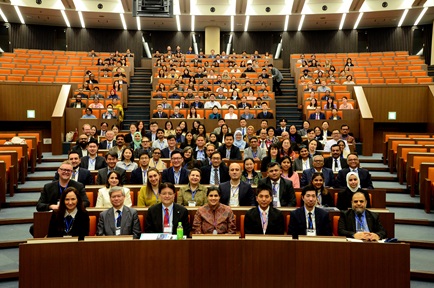Zooming in on the Foreign Direct Investment Landscape in Asian Emerging Markets
This report explores the location and sectoral FDI in Asia and adds insights on the evolution of motives for shifts in greenfield FDI inflows into each country of the region
By Nanyang Centre for Emerging Studies

Executive Summary
Foreign direct investment (FDI) inflows, an integral component of Asia’s strong economic performance over the last few decades, also facilitated the spread of regional production networks. Today, as the region emerges from the shadow of the United States (US)-China trade war and moves toward a post-pandemic normal, emerging markets such as Vietnam and India seek to position themselves to attract greater global FDI flows, and perhaps to capture FDI that may be re-directed from China in light of its strained relationship with the US.
Over the last decade, FDI in the Asian region shifted dramatically. China’s role as a source of Greenfield FDI became increasingly important, while the US share of such investments declined. Vietnam, a significant beneficiary of Greenfield FDI inflows to the region, overtook other ASEAN economies to become the region’s most attractive destination for new Greenfield investments. Most Greenfield FDI directed to large emerging markets such as India tends to originate outside of the ASEAN region, highlighting the potential to deepen regional ties. A sectoral perspective reveals the dominance of sectors such as real estate, coal, oil and gas, automotive and electronic components, financial services and hotels and tourism. Some of these sectors play important roles in the region’s participation in global value chains. Our analysis underlines the need for regional policymakers to pay close attention not only to the magnitude of Greenfield investments but also their ability to generate jobs. The current relationship between jobs created and the magnitude of Greenfield investments in the region is unclear.
Our report adds unique insights on the evolution of motives for shifts in Greenfield FDI inflows into each country of the region. Today, few firms seeking to invest in China view the country as a low-cost destination. This motivation pattern currently applies more to Vietnam, which appears to have gradually edged China out as the preferred low-cost destination for foreign investors. Despite perceptions that its domestic market growth potential has been on the decline over recent years, other emerging markets in the region such as India continues to attract a significant share of FDI owing to its highly skilled workforce. Global investor interest in Singapore continues to be driven by its proximity to and linkages with other markets. Overall, the presence of a predictable, stable and conducive regulatory environment is an important factor for firms considering new Greenfield investments.
A scan of the region’s regulatory environments reveals that countries such as China and Vietnam benefitted from marked relaxation of FDI-related restrictions over the last decade. However, the ASEAN regulatory environment is quite diverse. Some members, such as the Philippines and Indonesia, tend to have comparably tighter regulations than others; while small countries like Singapore set a high benchmark in terms of openness. Interestingly, some smaller countries in the region, such as Cambodia and Myanmar, have far more liberalized environments, comparable even to that in Singapore. Our analysis confirms that easing FDI restrictions creates more favorable foreign investment climates. One strong policy finding is that this trend is associated with greater Greenfield investments at the sectoral level.
Over the last decade, FDI in the Asian region shifted dramatically. China’s role as a source of Greenfield FDI became increasingly important, while the US share of such investments declined. Vietnam, a significant beneficiary of Greenfield FDI inflows to the region, overtook other ASEAN economies to become the region’s most attractive destination for new Greenfield investments. Most Greenfield FDI directed to large emerging markets such as India tends to originate outside of the ASEAN region, highlighting the potential to deepen regional ties. A sectoral perspective reveals the dominance of sectors such as real estate, coal, oil and gas, automotive and electronic components, financial services and hotels and tourism. Some of these sectors play important roles in the region’s participation in global value chains. Our analysis underlines the need for regional policymakers to pay close attention not only to the magnitude of Greenfield investments but also their ability to generate jobs. The current relationship between jobs created and the magnitude of Greenfield investments in the region is unclear.
Our report adds unique insights on the evolution of motives for shifts in Greenfield FDI inflows into each country of the region. Today, few firms seeking to invest in China view the country as a low-cost destination. This motivation pattern currently applies more to Vietnam, which appears to have gradually edged China out as the preferred low-cost destination for foreign investors. Despite perceptions that its domestic market growth potential has been on the decline over recent years, other emerging markets in the region such as India continues to attract a significant share of FDI owing to its highly skilled workforce. Global investor interest in Singapore continues to be driven by its proximity to and linkages with other markets. Overall, the presence of a predictable, stable and conducive regulatory environment is an important factor for firms considering new Greenfield investments.
A scan of the region’s regulatory environments reveals that countries such as China and Vietnam benefitted from marked relaxation of FDI-related restrictions over the last decade. However, the ASEAN regulatory environment is quite diverse. Some members, such as the Philippines and Indonesia, tend to have comparably tighter regulations than others; while small countries like Singapore set a high benchmark in terms of openness. Interestingly, some smaller countries in the region, such as Cambodia and Myanmar, have far more liberalized environments, comparable even to that in Singapore. Our analysis confirms that easing FDI restrictions creates more favorable foreign investment climates. One strong policy finding is that this trend is associated with greater Greenfield investments at the sectoral level.
About the author
The Nanyang Centre for Emerging Markets (CEM) is a new initiative by Nanyang Business School to establish global thought leadership on business-related issues in emerging markets. It conducts research on pressing and timely business issues in emerging markets through a global research platform of leading scholars and institutional partners. It closely interacts with corporate partners to identify research topics and manage the research process. Its research outputs include valuable and relevant implications for sustained profitable growth for local and multinational companies in emerging markets. It delivers a variety of research reports and organises forums, seminars, CEO roundtables, conferences, and executive training programmes for broad dissemination of its research outputs.
Read full report here.
Read full report here.







